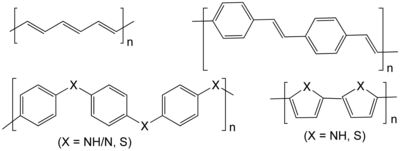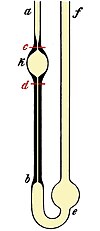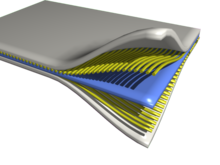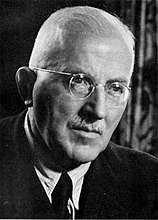Polymer chemistry

Polymer chemistryis a sub-discipline ofchemistrythat focuses on the structures of chemicals,chemical synthesis,andchemicaland physical properties ofpolymersandmacromolecules.The principles and methods used within polymer chemistry are also applicable through a wide range of other chemistry sub-disciplines likeorganic chemistry,analytical chemistry,andphysical chemistry.Many materials have polymeric structures, from fully inorganicmetalsandceramicstoDNAand otherbiological molecules.However, polymer chemistry is typically related tosyntheticandorganic compositions.Syntheticpolymers are ubiquitous in commercial materials and products in everyday use, such asplastics,andrubbers,and are major components ofcompositematerials. Polymer chemistry can also be included in the broader fields ofpolymer scienceor evennanotechnology,both of which can be described as encompassingpolymer physicsandpolymer engineering.[1][2][3][4]
History[edit]
The work ofHenri Braconnotin 1777 and the work ofChristian Schönbeinin 1846 led to the discovery ofnitrocellulose,which, when treated withcamphor,producedcelluloid.Dissolved inetheroracetone,it becomescollodion,which has been used as awounddressing since theU.S. Civil War.Cellulose acetatewas first prepared in 1865. In years 1834-1844 the properties of rubber (polyisoprene) were found to be greatly improved by heating withsulfur,thus founding thevulcanizationprocess.
In 1884Hilaire de Chardonnetstarted the first artificialfiberplant based on regeneratedcellulose,orviscoserayon,as a substitute forsilk,but it was very flammable.[5]In 1907Leo Baekelandinvented the first polymer made independent of the products oforganisms,athermosettingphenol-formaldehyderesin calledBakelite.Around the same time,Hermann Leuchsreported the synthesis ofamino acid N-carboxyanhydridesand their high molecular weight products upon reaction with nucleophiles, but stopped short of referring to these as polymers, possibly due to the strong views espoused byEmil Fischer,his direct supervisor, denying the possibility of any covalent molecule exceeding 6,000 daltons.[6]Cellophanewas invented in 1908 by Jocques Brandenberger who treated sheets of viscose rayon withacid.[7]
- Leading figures in polymer chemistry
-
Hermann Staudinger,father of polymer chemistry
-
Wallace Carothers,inventor of nylon.
-
Stephanie Kwolek,inventor ofKevlar.


The chemistHermann Staudingerfirst proposed that polymers consisted of long chains ofatomsheld together bycovalent bonds,which he calledmacromolecules.His work expanded the chemical understanding of polymers and was followed by an expansion of the field of polymer chemistry during which such polymeric materials as neoprene, nylon and polyester were invented. Before Staudinger, polymers were thought to be clusters of smallmolecules(colloids), without definitemolecular weights,held together by an unknownforce.Staudinger received theNobel Prize in Chemistryin 1953.Wallace Carothersinvented the firstsynthetic rubbercalledneoprenein 1931, the firstpolyester,and went on to inventnylon,a true silk replacement, in 1935.Paul Florywas awarded theNobel Prize in Chemistryin 1974 for his work on polymerrandom coilconfigurations in solution in the 1950s.Stephanie Kwolekdeveloped anaramid,oraromaticnylon namedKevlar,patented in 1966.Karl ZieglerandGiulio Nattareceived a Nobel Prize for their discovery ofcatalystsfor the polymerization ofalkenes.Alan J. Heeger,Alan MacDiarmid,andHideki Shirakawawere awarded the 2000 Nobel Prize in Chemistry for the development ofpolyacetyleneand related conductive polymers.[8]Polyacetylene itself did not find practical applications, butorganic light-emitting diodes(OLEDs) emerged as one application of conducting polymers.[9]
Teaching and research programs in polymer chemistry were introduced in the 1940s. An Institute for Macromolecular Chemistry was founded in 1940 in Freiburg, Germany under the direction of Staudinger. In America, a Polymer Research Institute (PRI) was established in 1941 byHerman Markat thePolytechnic Institute of Brooklyn(nowPolytechnic Institute of NYU).
Polymers and their properties[edit]

Polymersare high molecular mass compounds formed bypolymerizationofmonomers.They are synthesized by the polymerization process and can be modified by the additive of monomers. The additives of monomers change polymers mechanical property, processability, durability and so on. The simple reactive molecule from which the repeating structural units of a polymer are derived is called a monomer. Apolymercan be described in many ways: itsdegree of polymerisation,molar mass distribution,tacticity,copolymerdistribution, the degree ofbranching,by itsend-groups,crosslinks,crystallinityand thermal properties such as itsglass transition temperatureand melting temperature.Polymersinsolutionhave special characteristics with respect tosolubility,viscosity,andgelation.Illustrative of the quantitative aspects of polymer chemistry, particular attention is paid to the number-average andweight-average molecular weightsand,respectively.
The formation and properties of polymers have been rationalized by many theories includingScheutjens–Fleer theory,Flory–Huggins solution theory,Cossee–Arlman mechanism,Polymer field theory,Hoffman Nucleation Theory,Flory–Stockmayer theory,and many others.

The study of polymer thermodynamics helps improve the material properties of various polymer-based materials such aspolystyrene(styrofoam) andpolycarbonate.Common improvements includetoughening,improvingimpact resistance,improvingbiodegradability,and altering a material'ssolubility.[10]
Viscosity[edit]
As polymers get longer and their molecular weight increases, theirviscositytend to increase. Thus, the measured viscosity of polymers can provide valuable information about the average length of the polymer, the progress of reactions, and in what ways the polymer branches.[11]

Classification[edit]
Polymerscan be classified in many ways. Polymers, strictly speaking, comprise most solid matter: minerals (i.e. most of the Earth's crust) are largely polymers, metals are 3-d polymers, organisms, living and dead, are composed largely of polymers and water. Often polymers are classified according to their origin:

Biopolymersare the structural and functional materials that comprise most of the organic matter in organisms. One major class of biopolymers areproteins,which are derived fromamino acids.Polysaccharides,such ascellulose,chitin,andstarch,are biopolymers derived from sugars. The polynucleic acidsDNAandRNAare derived from phosphorylated sugars with pendant nucleotides that carry genetic information.
Synthetic polymersare the structural materials manifested inplastics,synthetic fibers,paints,building materials,furniture,mechanical parts, andadhesives.Synthetic polymers may be divided intothermoplastic polymersandthermoset plastics.Thermoplastic polymers includepolyethylene,teflon,polystyrene,polypropylene,polyester,polyurethane,Poly(methyl methacrylate),polyvinyl chloride,nylons,andrayon.Thermoset plasticsincludevulcanizedrubber,bakelite,Kevlar,andpolyepoxide.Almost all synthetic polymers are derived frompetrochemicals.
See also[edit]
References[edit]
- ^"The Macrogalleria: A Cyberwonderland of Polymer Fun".pslc.ws.Retrieved2018-08-01.
- ^Young, R. J. (1987)Introduction to Polymers,Chapman & HallISBN0-412-22170-5
- ^Odian, George G.Principles of polymerization(Fourth ed.). Hoboken, N.J.ISBN9780471478751.OCLC54781987.
- ^Hans-Heinrich Moretto, Manfred Schulze, Gebhard Wagner (2005) "Silicones" inUllmann's Encyclopedia of Industrial Chemistry,Wiley-VCH, Weinheim.doi:10.1002/14356007.a24_057
- ^"The Early Years of Artificial Fibres".The Plastics Historical Society.Retrieved2011-09-05.
- ^Kricheldorf, Hans, R. (2006), "Polypeptides and 100 Years of Chemistry of α-Amino Acid N-Carboxyanhydrides",Angewandte Chemie International Edition,45(35): 5752–5784,doi:10.1002/anie.200600693,PMID16948174
{{citation}}:CS1 maint: multiple names: authors list (link) - ^"History of Cellophane".about. Archived fromthe originalon June 29, 2012.Retrieved2011-09-05.
- ^"The Nobel Prize in Chemistry 2000".Retrieved2009-06-02.
- ^Friend, R. H.; Gymer, R. W.; Holmes, A. B.; Burroughes, J. H.; Marks, R. N.; Taliani, C.; Bradley, D. D. C.; Santos, D. A. Dos; Brdas, J. L.; Lgdlund, M.; Salaneck, W. R. (1999). "Electroluminescence in conjugated polymers".Nature.397(6715): 121–128.Bibcode:1999Natur.397..121F.doi:10.1038/16393.S2CID4328634.
- ^X Zhang, X Peng, SW Zhang. "7 - Synthetic biodegradable medical polymers: Polymer blends" Science and Principles of Biodegradable and Bioresorbable Medical Polymers, 2017. 217-254.
- ^"Viscosity of Polymer Solutions".polymerdatabase.Retrieved2019-03-05.






